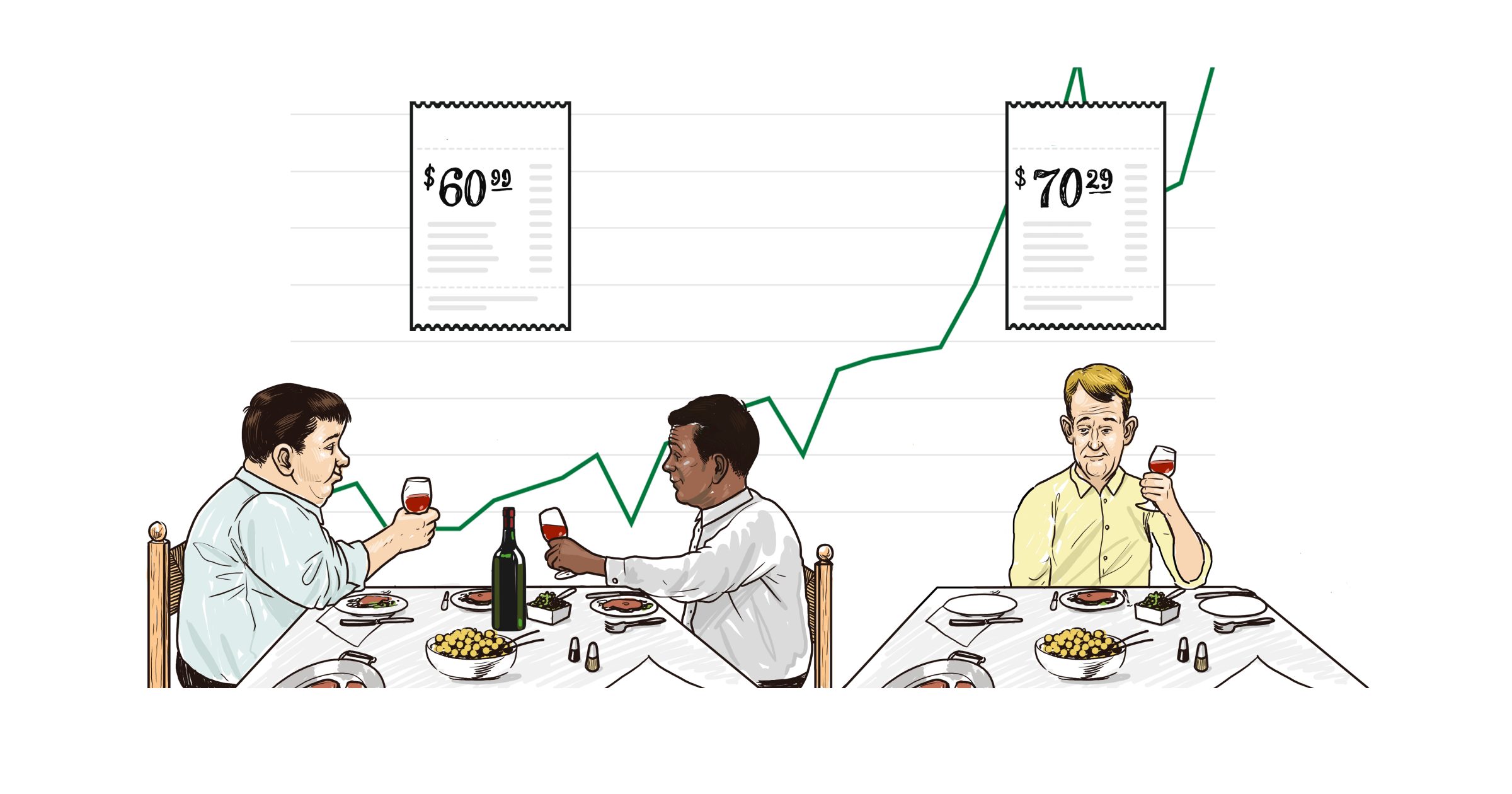What You’re Getting Wrong About Flavor
Everywhere she looks, Arielle Johnson sees a parallel universe.
She sees evidence of it every time she watches a chef properly season a piece of meat, or screw up a fermentation. It’s there when the aromas of fresh basil and mint waft off a steaming bowl of pho, or when the sour lime juice in a gin and tonic balances out the bitterness in the quinine. We tend to think these are all just matters of taste, but actually, there is a world of science behind them—a parallel universe of chemistry, that as Johnson explains in her new book Flavorama, rules that thing we call flavor.
“There is all this research about flavor out there that was useful and interesting to the chefs and cooks I was working with,” Johnson says. “But when they asked me what book they could read to learn more about it, I would have to say that unless they wanted to work through a pile of academic papers, there wasn’t anything. Eventually I stopped being stupid and was like oh, I guess I should write that book.”
Johnson first got interested in food back in the heady days at the start of the century, when Ferran Adria was posing on magazine covers with a fetching dollop of ruby-colored foam, and Jeffrey Steingarten was filling his restaurant column for Vogue with rumors of a strange new form of cooking that went by the name ‘molecular.’ Going to college at NYU at the same time as the influential Experimental Cuisine Collective was taking off there solidified that interest, and led to graduate work in chemistry (and a PhD in flavor perception and analytical chemistry). From there Johnson moved to noma, where, as in-house scientist and all-around chef-whisperer, she was involved in projects like building the restaurant’s first fermentation lab and figuring out how to rotovap a habanero so it yielded its fruity flavors with none of its spiciness.
That trajectory— which has included stints advising other restaurants and food producers—convinced her that there was a need for the kind of knowledge she had cultivated by working at the intersection of the kitchen and the lab. “You may intuitively know some of this,” she says. “But there’s a parallel chemistry to it that explains how flavor works. If you understand that, it enables you to do things you wouldn’t know how to do without, say, moving to Japan and spending nine months in a soy sauce factory”.
Her precise yet irreverent approach (this is a scientist who compares the aromatic compounds known as terpenes to Werner Herzog movies), allows her not only to explain the complexities of food science in a clear and accessible way, but also to bust through the some of the the myths chefs tell themselves about how flavor works. So for this issue of MAD Digest, we invited Johnson to dispel some of the cheffy misconceptions she comes across.
1. No, you do not have a naturally gifted palate
We all love a story about the genius chef who can tell not only detect that drop of fish sauce in the vegetable stock, but tell you which brand it is as well. Yet a good palate, Johnson says, is an acquired skill, not some kind of mystical trait you’re born with. As someone who has trained dozens of civilians (an education which, by the way, sounds super fun, involving as it does dark glasses and Jelly Bellys) to identify and describe flavor, she’s observed the transformation firsthand. “A chef who has been in the business for a while doesn’t have more innate talent; they’ve just had more exposure and practice,” she says. “Your average chef is going to have a kind of more clued-in palate than your average regular person, because it’s a feature of their job. And once you get good at it, it feels very natural and intuitive. But it wasn’t always like that; you had to learn it.”
2. Flavor = Taste+Smell. But that doesn’t mean you should go spraying essential oils over your food
There was a misguided culinary moment about fifteen years ago when you’d be at an ambitious restaurant and at some point over the course of what was inevitably a very long tasting menu, a server would come over and spritz the dish you were about to eat, or the air around you, or worst of all, you yourself with some kind of aromatic something. The assault usually occurred because the chef had recently read something about how scent enhances flavor, which, as Johnson points out, is definitely true. A big part of Flavorama is devoted to explaining just how much of what we experience as flavor comes not from taste alone–because that is pretty much limited to the big 5 of salty, sweet, sour, bitter, umami—but rather from the mix of those tastes with the far more numerous and diverse smells we can detect.
But that still doesn’t mean you should go dousing your food in perfume. “All the complexity and dimension of a dish is going to come from the aromas, but the connection that people don’t really get is that most of the smell perception you’re doing while you’re eating isn’t about sniffing–it comes from smelling the food that is already inside your mouth,” she says. “Your brain plays a trick on you: you’re sensing smell, but you literally, physically, feel like it’s happening on your tongue.” So while adding scent to the environment can radically change the sensory experience of a dish, “the innate flavors that are in the ingredients are still important because that’s what you’re ‘tasting’ when you’re eating it.”
3. Your fermentations would be better if you actually knew what you (and the molecules) were doing
“I see a lot of bad fermentation,” Johnson says. “Every time I taste an off flavor, I think ‘if you knew what that meant, you really could have avoided this.’” Fermentation may seem like alchemy—throw some random ingredients in a bucket; wait awhile; get culinary gold—but it is a process governed by rules of chemistry, and understanding those rules is critical if you want to control the outcome in your misos and garums. “Being able to connect particular flavors to biochemical points in the process makes it much easier to make your fermentation do what you want.”
She remembers one chef who was stumped because his miso kept coming out sweet, without the umami punch he expected. When she asked after the ingredients, she learned he was using only grains, without the protein that the ferment requires to produce umami flavors. (Though if that protein source is dairy, you should expect a blue cheese flavor, she adds, because the particular fats in milk break down in a way that will make your miso taste like Roquefort). And she can’t recall the number of times a cook has come to her complaining that their vinegar wasn’t working out, only to discover that they had missed a critical step. ‘‘They would tell me, “I took the juice and then I added the vinegar to it as a starter, but nothing’s happening.’ And I would say, ‘Ok, but what about the alcohol?’ And they would be like, ‘No, why would I add alcohol?’ But fundamentally, you cannot make a vinegar without alcohol–that’s what the bacteria converts to acetic acid, it’s what it needs to eat. So the cook would go away, and add alcohol, and then come back and say, ‘Oh my god, how did you know?’”
4. Conventional wisdom–even the conventional wisdom you picked up in culinary school–isn’t always right
By this point in your career, you have probably realized that that thing about searing meat to lock in the juices is a lie, and no, beans turn out tough if you salt the water before turning on the heat. But if you’re like a lot of chefs Johnson has encountered, you’re still operating under some misconceptions that can get in the way of better cooking. “For everything you know how to do as a chef, there’s a scientific reason why it works. There’s a mechanism, and if you understand that mechanism, you can experiment and improve your cooking much much much faster than with just trial and error,” Johnson says. “But the mechanism often isn’t what you think it is.”
Take lemon juice, for example. Chances are, you’ve learned to add it only at the end of the cooking process, because otherwise, the dish will taste flat–an outcome that many people believe is the result of heat reducing the acidity. “But that’s not true. You’re not changing the acidity; you’re boiling off the aroma compounds. So what tastes flat to you is not actually less acidic; it’s just flavor without smell. And if you know your differences you can add something with a lemony aroma that will brighten up the taste— lemongrass, lemon verbena, lemon thyme, even sometimes, just another fresh herb will pick it up enough. It’ll actually make things taste brighter or deeper or balanced in a way that you wouldn’t get just by adding more lemon juice to it.”
5. You have a bigger role to play in building a sustainable food system than you may think
When it comes to making food kinder on the planet and better for human health, flavor has a huge role to play. For one, we’re hardwired to respond to it. “We are supposed to be flavor-experiencing creatures; we are literally built to get an enjoyable feeling from our food,” Johnson explains. “And if there’s less pleasure, like if we lose our sense of smell or if the food itself is less flavorful, humans will actually get depressed.”
So if you want to change the way people eat—by, say, encouraging them to reduce food waste or start consuming insects—you have to start with making sure what they eat tastes good. But the entities producing or regulating most of what we eat don’t necessarily see it that way. “The questions that large companies or government agencies ask about food are about yield and uniformity,” she says. And for them, “flavor is sort of frivolous.”
But flavor, she argues, can’t be separated out from a healthy food system. “One of the big problems in our modern systems is that flavor has suffered and nutrition has suffered, and these things are not unrelated. There appears to be some relationship between the flavor compounds in plants, and the nutritionally bioactive ones. The research is still very early, but it suggests that a lot of flavor compounds are either related to things like vitamins or are vitamins themselves.”
So when Johnson thinks about the future of food, the parallel universe of flavor and the chemistry that rules it figures prominently. And that means getting experts in flavor–which is to say chefs, sommeliers, baristas and bartenders–a seat at the table. “The more people who work with flavor in this very intimate way have a voice and an influence in startups and over policy, the better we’re going to be able to shape a framework based on values. If we don’t want a food system that is completely dystopian, flavor needs to be 100% integral.”




